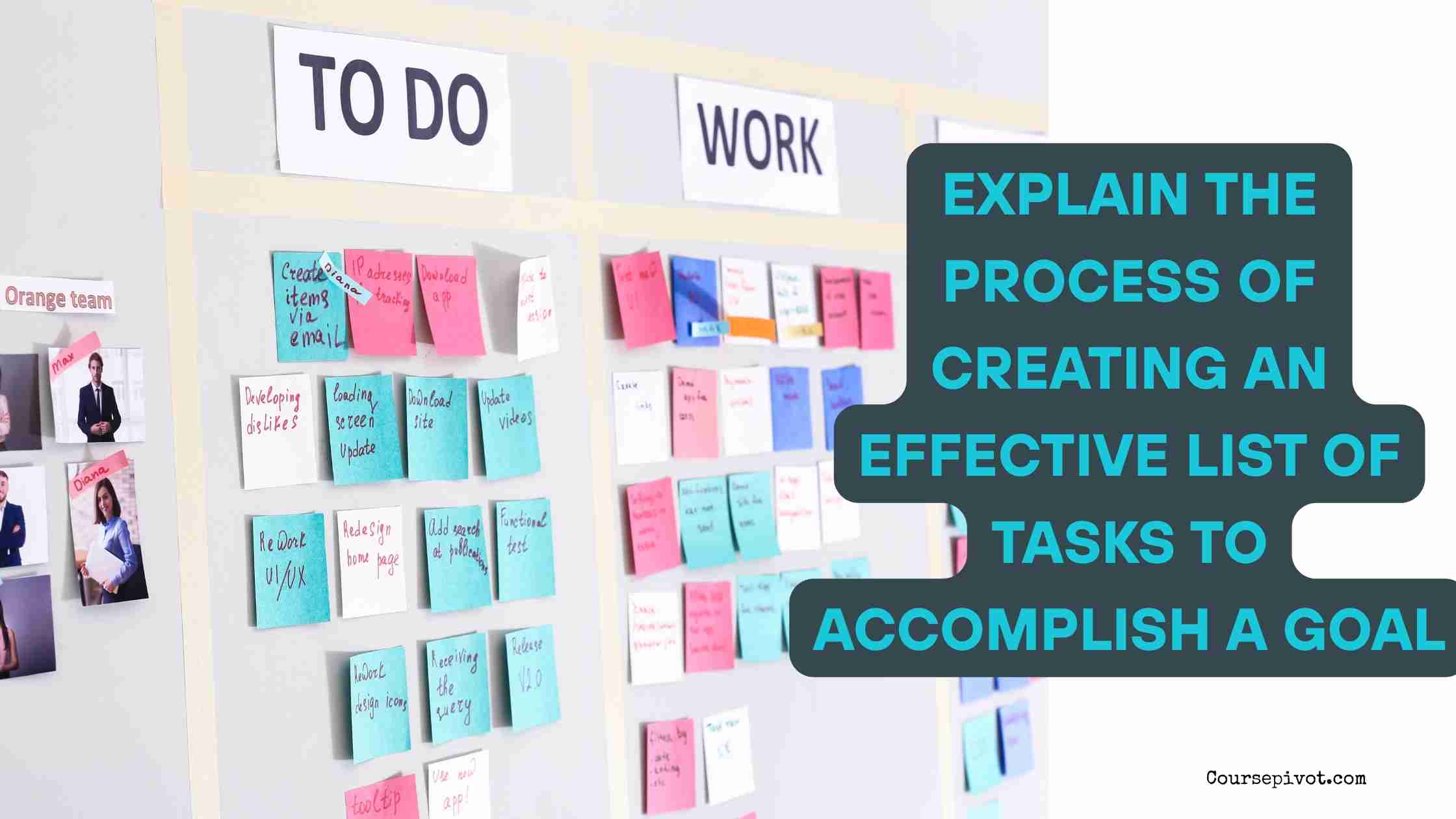
Explain the Process of Creating an Effective List of Tasks to Accomplish a Goal
You’ve got a goal. Maybe it’s launching a business, writing a book, or finally getting in shape. But have you ever sat down to tackle it—only to feel overwhelmed, scattered, or unsure where to even start?
Here’s the truth: A goal without a clear list of tasks is just a wish.
If you want to turn big ideas into real results, you need to break that goal down into actionable steps. That means creating an effective task list—not just any list, but one that drives momentum, removes confusion, and helps you track progress with purpose.
Table of Contents
So let’s explain the process of creating an effective list of tasks to accomplish a goal, step by step.
🎯 Step 1: Define the Goal Clearly
Before you list a single task, you need clarity.
Ask yourself:
- What exactly am I trying to achieve?
- What will success look like?
- Is this goal SMART?
(Specific, Measurable, Achievable, Relevant, Time-bound)
✍️ Write it down:
Bad example: “Get fit”
Better example: “Lose 10 pounds in 3 months through exercise and healthy eating”
This specific goal now becomes the anchor for your task list.
- Our trending blogs:
- Explain the Difference Between Essential Body Fat and Storage Body Fat
- Explain What Distinguishes First Class Levers from Second and Third Class Levers
- Explain Why There Must Be at Least Two Lines on Any Given Plane
🧠 Step 2: Break It Down Into Milestones
Large goals are overwhelming when viewed as a whole. So, split your goal into milestones or phases.
Ask:
What major components or stages are involved in reaching this goal?
For example, if your goal is to “Start an online business in 90 days,” your milestones might include:
- ✅ Market research
- ✅ Product development
- ✅ Website creation
- ✅ Marketing launch
These are your checkpoint goals, and each will eventually hold its own list of tasks.
🧩 Step 3: List Every Task Needed to Complete Each Milestone
Here’s where the actual task list starts to form.
Take each milestone and brain-dump every single task you can think of to make it happen. Don’t worry about the order yet—just get it all out.
For example, under “Product development,” your tasks might include:
- Choose product idea
- Source materials
- Create a prototype
- Get feedback
- Revise product
Be thorough but practical. If a task seems too vague, break it into smaller steps. The more specific your tasks, the easier they are to act on.
📌 Step 4: Prioritize and Organize
Once you’ve listed everything, the next move is putting the tasks in logical order and marking the priority level.
- Use a system like:
- 🔴 High priority (urgent, time-sensitive)
- 🟡 Medium priority (important, but not urgent)
- 🟢 Low priority (can wait or delegate)
You can also use labels or categories:
Admin tasks, creative tasks, outreach tasks, research tasks, etc.
Then, order the tasks from first to last based on what logically needs to happen before the next step.
⏱️ Step 5: Assign Deadlines
A task list without deadlines is just another to-do list you’ll ignore.
Ask:
- How long will this task realistically take?
- What’s the best time to do it?
- What’s the consequence if this task is delayed?
Use calendar tools, planners, or project management apps like Trello, Notion, or Asana to add these dates.
Be flexible, but hold yourself accountable.
🧩 Step 6: Review, Adjust, and Track Progress
Your list isn’t set in stone—it’s a living document.
Revisit it regularly. Update it as you learn more or complete parts of your goal. Cross off completed tasks—it gives you a psychological reward and keeps momentum going.
Ask weekly:
- What did I accomplish?
- What needs more attention?
- Where am I stuck—and why?
Use this reflection to tweak your list as needed.
🧠 Why Task Lists Matter for Goal Success
Creating a task list might seem simple—but doing it right is what transforms wishful thinking into repeatable, goal-crushing action.
It helps you:
- Stay focused
- Avoid procrastination
- Measure progress
- Boost motivation
- Feel in control of big, scary goals
So, what’s the process of creating an effective list of tasks to accomplish a goal?
It’s a six-step journey:
- Define your goal clearly
- Break it into milestones
- List every task for each milestone
- Prioritize and organize those tasks
- Assign deadlines
- Track, review, and adjust
This method is how I’ve written books, launched projects, even tackled major life changes. When you map out every step, progress stops feeling vague and starts feeling inevitable.
If you want real results, stop relying on motivation—and start relying on a well-crafted task list.
Cite this article
You can copy and paste your preferred citation format below.
Martin, L. & Arquette, E.. (2025, May 23). Explain the Process of Creating an Effective List of Tasks to Accomplish a Goal. Coursepivot.com. https://coursepivot.com/blog/explain-the-process-of-creating-an-effective-list-of-tasks-to-accomplish-a-goal/



